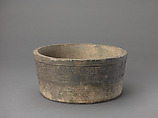Returned to lender The Met accepts temporary loans of art both for short-term exhibitions and for long-term display in its galleries.
Inscribed Measure
Qin dynasty (221–206 BC)
Not on view
Both the weight and the measure are inscribed with the same edict:
In the twenty-sixth year (i.e., 221 B.C.), the Emperor completely unified the regional lords of the All-under-Heaven. The black-headed ones (i.e., the common people) were at great peace, and he established the title of “Emperor.” Now he commands the Chief Ministers [Wei] Zhuang and [Wang] Wan. As for the standards, lengths, measures, and rules that are not unified and are doubtful, clarify and unify them all.
The inscription demonstrates efforts to unify and standardize systems throughout the Qin Empire, one of the first undertaken by the new regime. Not only did it enable the collection of grain taxes at a uniform rate throughout the conquered territories, but it also communicated to the widest possible audience the legitimacy and authority of the empire.
The weight is notable in that it is made of iron, not bronze; only the largest weights in the Qin system were. This example weighs 120 jin, or 1 shi (literally, “stone”). To prevent corruption, Qin officials could not use weights that deviated from state-mandated norms, which was one way of ensuring that people recognized the legitimacy of the Qin regime.
This image cannot be enlarged, viewed at full screen, or downloaded.
This artwork is meant to be viewed from right to left. Scroll left to view more.






